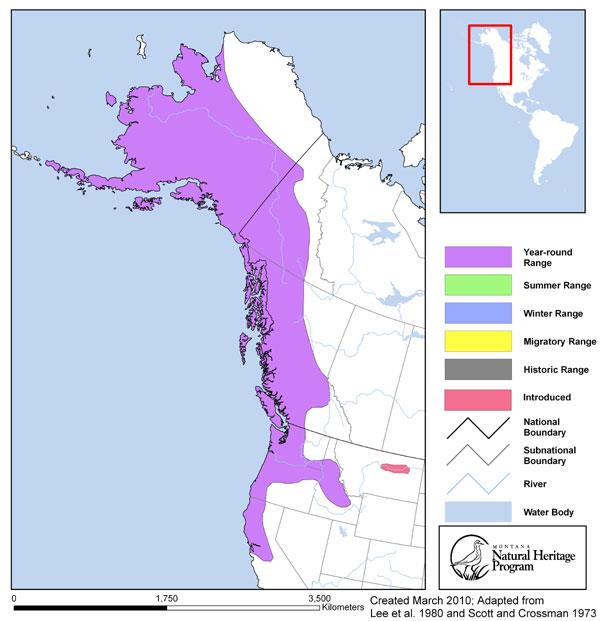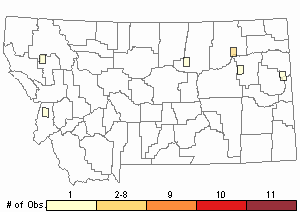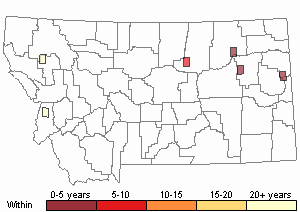View in other NatureServe Network Field Guides
NatureServe
Montana
Utah
Wyoming
Idaho
Wisconsin
British Columbia
South Carolina
Yukon
California
New York
Chinook Salmon - Oncorhynchus tshawytscha
General Description
One of two Pacific salmon species in Montana, the chinook salmon, was introduced into Fort Peck Reservoir during the 1980s in an effort to produce a trophy fishery. Like all Pacific salmon species, the chinook dies after spawning. It is doubtful that these fish will reproduce in Fort Peck, but due to their intense homing instinct they will return to where they were stocked when they are ready to spawn. They may then be captured and artificially propagated in the hatchery. While still experimental, chinooks of over 25 pounds have already been captured in Montana. Chinook, also known as "king salmon", are intense fish predators as adults.
Diagnostic Characteristics
Anal fin usually has 14 to 19 rays; its base is longer than base of dorsal fin. Has 26 or fewer gill rakers on first arch. Breeding males develop an elongated hooked snout and enlarged teeth. Females change little. Breeding fish of both sexes darken in color, males more than females. (FWP) Differs from other oncorhynchus by large size (to 45 kg), small black spots on both lobes of the caudal fin, black pigment along the base of the teeth, large number of pyloric caeca (>100), and variable flesh color (white to pink or red); fry and parr have large parr marks extending well below the lateral line (Healey 1991).
Species Range
Montana Range
Range Descriptions

 Non-native
Non-native
Western Hemisphere Range

Observations in Montana Natural Heritage Program Database
Number of Observations: 32
(Click on the following maps and charts to see full sized version)
Map Help and Descriptions
Relative Density

Recency



 (Observations spanning multiple months or years are excluded from time charts)
(Observations spanning multiple months or years are excluded from time charts)
Migration
Smolts planted in tributary migration downstream in a lake.
Habitat
A pelagic deep water species. Freshwater populations may spawn in rivers flowing into lake or on gravel shoals in the lake. The young may stay in the stream for a year or two before migrating downstream to the lake. There are no reproducing populations in Montana.
Food Habits
Adults highly piscivorous. Eat pelagic fishes such as cisco goldeye. Young in lake undoubtedly eat insects and plankton until large enough to eat fish.
Ecology
Very limited spawning success in Great Lakes. Maintained by artificial propagation. Wholly self-sustaining freshwater populations exist only in New Zealand.
Reproductive Characteristics
No sign of natural reproduction in Montana. May run in spring, but invariably spawn during late summer-fall. Eggs hatch following spring. Adults die after spawning. Sexually mature in Lake Superior mostly at 2-3 yrs.
Management
Stewardship Responsibility
References
- Literature Cited AboveLegend:
 View Online Publication
View Online Publication Healey, M.C. 1991. Life history of chinook salmon (Oncorhynchus tshawytscha). Pages 311-93 in C. Groot and L. Margolis (editors). Pacific Salmon Life Histories. University of British Columbia Press, Vancouver, British Columbia, Canada. xv + 564 pp.
Healey, M.C. 1991. Life history of chinook salmon (Oncorhynchus tshawytscha). Pages 311-93 in C. Groot and L. Margolis (editors). Pacific Salmon Life Histories. University of British Columbia Press, Vancouver, British Columbia, Canada. xv + 564 pp. Lee, D.S., C.R. Gilbert, C.H. Hocutt, R.E. Jenkins, D. E. McAllister, J. R. Stauffer, Jr. 1980. Atlas of North American freshwater fishes. North Carolina State Musuem of Natural History. 867 p.
Lee, D.S., C.R. Gilbert, C.H. Hocutt, R.E. Jenkins, D. E. McAllister, J. R. Stauffer, Jr. 1980. Atlas of North American freshwater fishes. North Carolina State Musuem of Natural History. 867 p. Scott, W.B. and E.J. Crossman. 1973. Rainbow trout, Kamloops trout, Steelhead trout Salmo gairdneri Richardson. pp. 184-191. In: Freshwater fishes of Canada. Ottawa, Canada: Fisheries Research Board of Canada, Bulletin 184. 966 p.
Scott, W.B. and E.J. Crossman. 1973. Rainbow trout, Kamloops trout, Steelhead trout Salmo gairdneri Richardson. pp. 184-191. In: Freshwater fishes of Canada. Ottawa, Canada: Fisheries Research Board of Canada, Bulletin 184. 966 p.
- Additional ReferencesLegend:
 View Online Publication
View Online Publication
Do you know of a citation we're missing? Cohn, L. and S. Henjum. Salmon Savior. Northwest Magazine, April 1991. pp. 8-12.
Cohn, L. and S. Henjum. Salmon Savior. Northwest Magazine, April 1991. pp. 8-12. Fickeisen, D.H., and J.C. Montgomery. 1978. Tolerances of fishes to dissolved gas supersaturation in deep tank bioassays. Trans. Am. Fish. Soc. 107(2):376-381.
Fickeisen, D.H., and J.C. Montgomery. 1978. Tolerances of fishes to dissolved gas supersaturation in deep tank bioassays. Trans. Am. Fish. Soc. 107(2):376-381. Joslin, Gayle, and Heidi B. Youmans. 1999. Effects of recreation on Rocky Mountain wildlife: a review for Montana. [Montana]: Montana Chapter of the Wildlife Society.
Joslin, Gayle, and Heidi B. Youmans. 1999. Effects of recreation on Rocky Mountain wildlife: a review for Montana. [Montana]: Montana Chapter of the Wildlife Society. Marcus, M.D., M.K. Young, L.E. Noel and B.A. Mullan. 1990. Salmonid-habitat relationships in the western United States: a review and indexed bibliography. USFS General Tech. Report RM-188. 84 p.
Marcus, M.D., M.K. Young, L.E. Noel and B.A. Mullan. 1990. Salmonid-habitat relationships in the western United States: a review and indexed bibliography. USFS General Tech. Report RM-188. 84 p. Montana Department of Fish, Wildlife and Parks. 1989. Northeast Montana Warmwater Ecosystem Investigations: project period 7/1/88 through 6/30/89. Proj.# F-46-R-2; Job# V-e. 21p.
Montana Department of Fish, Wildlife and Parks. 1989. Northeast Montana Warmwater Ecosystem Investigations: project period 7/1/88 through 6/30/89. Proj.# F-46-R-2; Job# V-e. 21p. Mullins, M.S. 1991. Biology and predator use of cisco (Coregonus artedi) in Fort Peck Reservoir, Montana. M.Sc. Thesis. Bozeman, MT: Montana State University. 68 p.
Mullins, M.S. 1991. Biology and predator use of cisco (Coregonus artedi) in Fort Peck Reservoir, Montana. M.Sc. Thesis. Bozeman, MT: Montana State University. 68 p. Opitz, S.T. 1999. Effects of whirling disease on recruitment of brown trout in the Ruby River and Poindexter Slough, Montana. M.Sc. Thesis. Bozeman, MT: Montana State University. 97 p.
Opitz, S.T. 1999. Effects of whirling disease on recruitment of brown trout in the Ruby River and Poindexter Slough, Montana. M.Sc. Thesis. Bozeman, MT: Montana State University. 97 p. Young, B.A., T.L. Welker, M.L. Wildhaber, C.R. Berry, and D. Scarnecchia (eds). 1997. Population structure and habitat use of benthic fishes along the Missouri and Lower Yellowstone Rivers. 1997 Annual report of Missouri River Benthic Fish Study PD-95-5832 to U.S. Army Corps of Engineers and U.S. Bureau of Reclamation. 207 p.
Young, B.A., T.L. Welker, M.L. Wildhaber, C.R. Berry, and D. Scarnecchia (eds). 1997. Population structure and habitat use of benthic fishes along the Missouri and Lower Yellowstone Rivers. 1997 Annual report of Missouri River Benthic Fish Study PD-95-5832 to U.S. Army Corps of Engineers and U.S. Bureau of Reclamation. 207 p. Zymonas, N.D. 2006. Age structure, growth, and factors affecting relative abundance of life history forms of Bull Trout in the Clark Fork river drainage, Montana and Idaho. M.Sc. Thesis. Bozeman, MT: Montana State University. 142 p.
Zymonas, N.D. 2006. Age structure, growth, and factors affecting relative abundance of life history forms of Bull Trout in the Clark Fork river drainage, Montana and Idaho. M.Sc. Thesis. Bozeman, MT: Montana State University. 142 p.
- Web Search Engines for Articles on "Chinook Salmon"
- Additional Sources of Information Related to "Fish"





